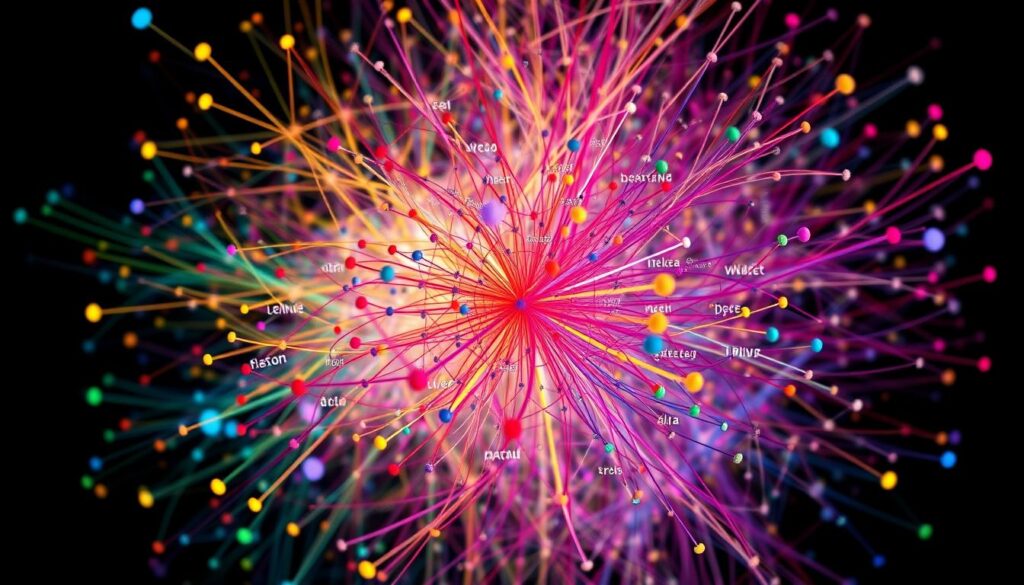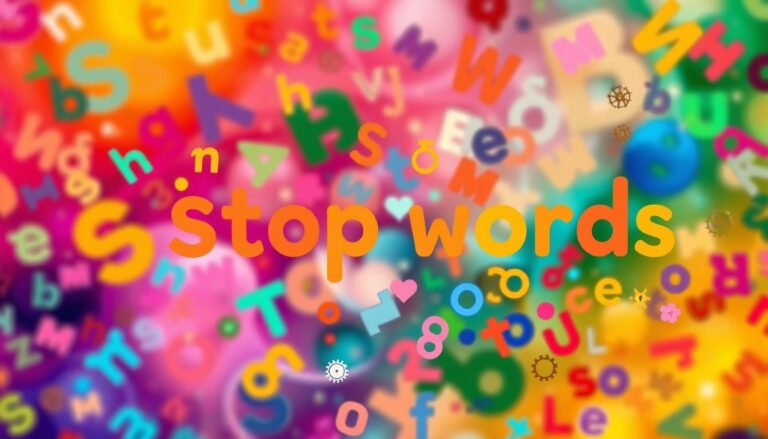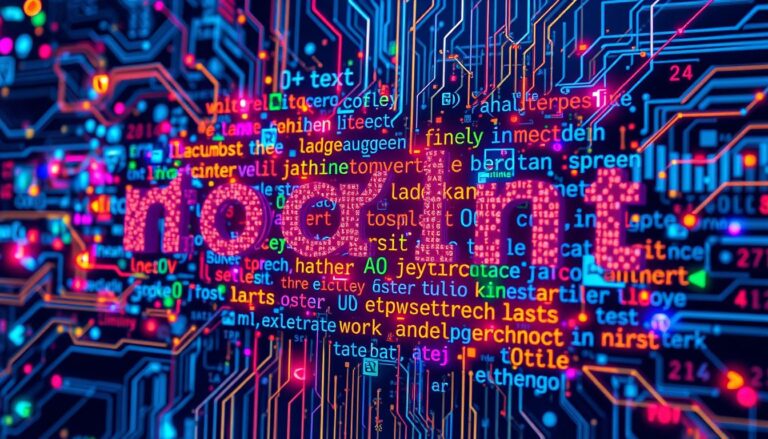What are word embeddings, and how are they used in NLP?
Word embeddings are key in natural language processing (NLP). They change how machines understand text. These numeric forms of words in a lower-dimensional space hold the meaning and structure of language. This lets machines see how words relate and are similar.
Word embeddings are vital for many NLP tasks. These include text classification, named entity recognition, and machine translation. They also help with information retrieval and question answering. By turning words into vectors, word embeddings help machines understand human language better than old methods like bag-of-words.
Language models like Word2Vec, GloVe, and BERT have made word embeddings even more powerful. These models are pre-trained and used as a base for many NLP tasks. They use neural networks and statistics to create word representations. These representations capture the context and meaning of language.
Introduction to Word Embeddings
Definition of Word Embeddings
Word embeddings, also known as word vector representation, are key in natural language processing (NLP). They turn words into numerical vectors. This method places semantically similar words close to each other in a lower-dimensional space.
Unlike methods like Bag of Words (BOW) and TF-IDF, word embeddings keep context and word relationships. They help machine learning models grasp the meaning and connections between words. This makes them better at understanding text.
The space for text embeddings is high-dimensional, often with 768 or 1536 dimensions. Embeddings enhance NLP models for tasks like search and conversational agents. Metrics like Euclidean distance and cosine distance measure how close words are in this space.
While 30,000 words work for bag-of-words models, scaling up is hard. Methods like Latent Semantic Analysis (LSA) and Latent Dirichlet Allocation (LDA) help with topic modeling. Neural networks are also used to create embeddings, making them more accurate.
Need for Word Embeddings
Traditional text methods like one-hot encoding and Bag of Words (BOW) have big problems. They create high-dimensional, sparse vectors that miss the point of word relationships. They also can’t handle words they’ve never seen before.
TF-IDF is better, but it still can’t fully grasp the complex nature of language. That’s where word embeddings step in. They offer a dense, lower-dimensional way to represent words, keeping their meaning and structure intact.
Word embeddings tackle the big challenges of dimensionality reduction and capturing semantic and syntactic information. This lets machine learning models understand and work with natural language better. As a result, they do much better in tasks like analyzing sentiment, classifying text, and creating language.
| Traditional Approach | Limitations |
|---|---|
| One-Hot Encoding | High-dimensional, sparse vectors that fail to capture semantic relationships |
| Bag of Words (BOW) | Neglects word order and suffers from sparsity issues |
| TF-IDF | Lacks the ability to fully represent contextual and relational information |
On the other hand, word embeddings give us a dense, lower-dimensional way to represent words. This makes natural language processing much more effective.

Approaches for Text Representation
In natural language processing (NLP), we have two main ways to represent text: traditional and neural. Traditional methods like one-hot encoding, Bag of Words (BOW), and Term Frequency-Inverse Document Frequency (TF-IDF) look at word frequency. They ignore the context and word relationships. Neural methods, such as Word2Vec and GloVe, use machine learning to learn word embeddings. These capture the meaning and structure of words.
Traditional Approaches
One-hot encoding represents each word as a binary vector. The vector’s length matches the vocabulary size, with one element set to 1 for a specific word. This method overlooks word relationships, leading to high-dimensional, sparse vectors.
Bag of Words (BOW) represents a document as a vector of word counts. It ignores word order and context. This method is simple but misses the semantic connections between words.
Term Frequency-Inverse Document Frequency (TF-IDF) assigns weights to words based on their importance. It considers a word’s frequency in a document and its rarity in the corpus. This approach helps determine word relevance.
Neural Approaches
Neural approaches like Word2Vec and GloVe use machine learning to learn word embeddings. These models represent words as dense vectors in a lower-dimensional space. The distance and direction between vectors show word similarity and relationships.
Word2Vec predicts a target word based on its context. GloVe learns embeddings by factorizing a word-word co-occurrence matrix. Both capture global statistical information about the corpus.
The choice of text representation depends on the NLP task, dataset size, and desired semantic understanding. Traditional methods work well for simple tasks. Neural approaches offer more accurate and nuanced representations, especially for tasks needing deep language understanding.
Natural Language Processing and Word Embeddings
Word embeddings are key in Natural Language Processing (NLP). They help machines understand word meanings better. This leads to better performance in many NLP tasks.
Some important NLP tasks that use word embeddings include:
- Text Classification (e.g., sentiment analysis, spam detection)
- Named Entity Recognition
- Machine Translation
- Information Retrieval
- Question Answering
Word embeddings turn words into vectors in a continuous space. This helps models understand word meanings better. It also helps in training more advanced models like BERT and GPT.
Older methods like one-hot encoding make data too big for models. Word embeddings solve this by making data smaller while keeping word meanings intact.
Models like Word2Vec and GloVe use neural networks to group similar words together. BERT has taken it further by looking at how words relate to each other in text. This has greatly improved language understanding.
Word embeddings are very useful in NLP but have their challenges. They struggle with words that have many meanings and words not in their vocabulary. New methods like contextual embeddings and subword tokenization are helping to solve these problems.
History of Word Embeddings
The journey of word embeddings in natural language processing (NLP) has been long and exciting. It started with the work of early researchers. They introduced neural language models and distributed representations of words in the early 2000s.
In 2003, Bengio et al. showed how neural networks could learn word representations. This was a big step forward. Mnih and Hinton (2009) then looked into using probabilistic models for word representations. They predicted the big changes that were coming.
The big leap happened in 2013 with Word2Vec by Tomas Mikolov and his team at Google. Word2Vec used the Continuous Bag of Words (CBOW) and Continuous Skip-gram models. It changed NLP forever.
In 2014, Pennington et al. came up with GloVe. It was a new way to make word embeddings using global statistics. This added more tools to the NLP toolbox. Word2Vec and GloVe made word embeddings a key part of NLP.
The story of word embeddings shows how far NLP has come. From the first ideas to Word2Vec and GloVe, it’s a story of growth and improvement. It highlights the power of unsupervised learning in NLP and the amazing progress we see today.
How Word Embeddings are Created
The creation of word embeddings starts with training a model on a large text dataset. First, the text is broken down into individual words. Then, stop words and punctuation are removed, and the text is cleaned.
A context window is applied to the text. This window looks at the words around a target word. These surrounding words are seen as context words.
The word embedding model is trained to guess a target word based on its context. This training captures various linguistic patterns. It assigns each word a unique vector, showing how similar or different words are.
The model adjusts its parameters to match predicted and actual words. This results in word vectors that keep the meaning and structure of words.
Neural networks in the word embedding training process learn word co-occurrence patterns. They turn these patterns into numerical vectors, called word embeddings. These embeddings help in tasks like text classification and sentiment analysis.
| Word Embedding Model | Key Features |
|---|---|
| Word2Vec | A two-layer neural network-based algorithm that outputs a set of vectors, potentially up to 1000 dimensions. |
| GloVe (Global Vectors) | Infers the meaning of a word from its co-occurrence with other words in the corpus. |
| fastText | Represents words as a bag of character n-grams instead of individual words. |
| ELMo | Utilizes a deep neural network to analyze the context of the word appearance. |
Understanding the word embedding training process and the different models helps in using word embeddings. This knowledge drives progress in natural language processing. It leads to better results in many language tasks.

Conclusion
Word embeddings have changed the game in Natural Language Processing (NLP). They let us represent words in a way that shows their meaning and how they relate to each other. This has helped machine learning models understand and work with natural language better.
This has led to big improvements in many NLP tasks. These include things like text classification, finding named entities, and even translating languages. It’s also helped with searching for information and answering questions.
The story of word embeddings started with early work on neural language models. It grew into the use of Word2Vec and GloVe. As NLP keeps getting better, word embeddings will keep being a key part. They will help create even more advanced ways for machines to understand and make language.
Looking at word embeddings, their role in NLP, and what’s next shows how important they are. They are key to making artificial intelligence better at talking and understanding human language. As we keep exploring NLP, word embeddings will be a big part of making progress in this exciting field.







